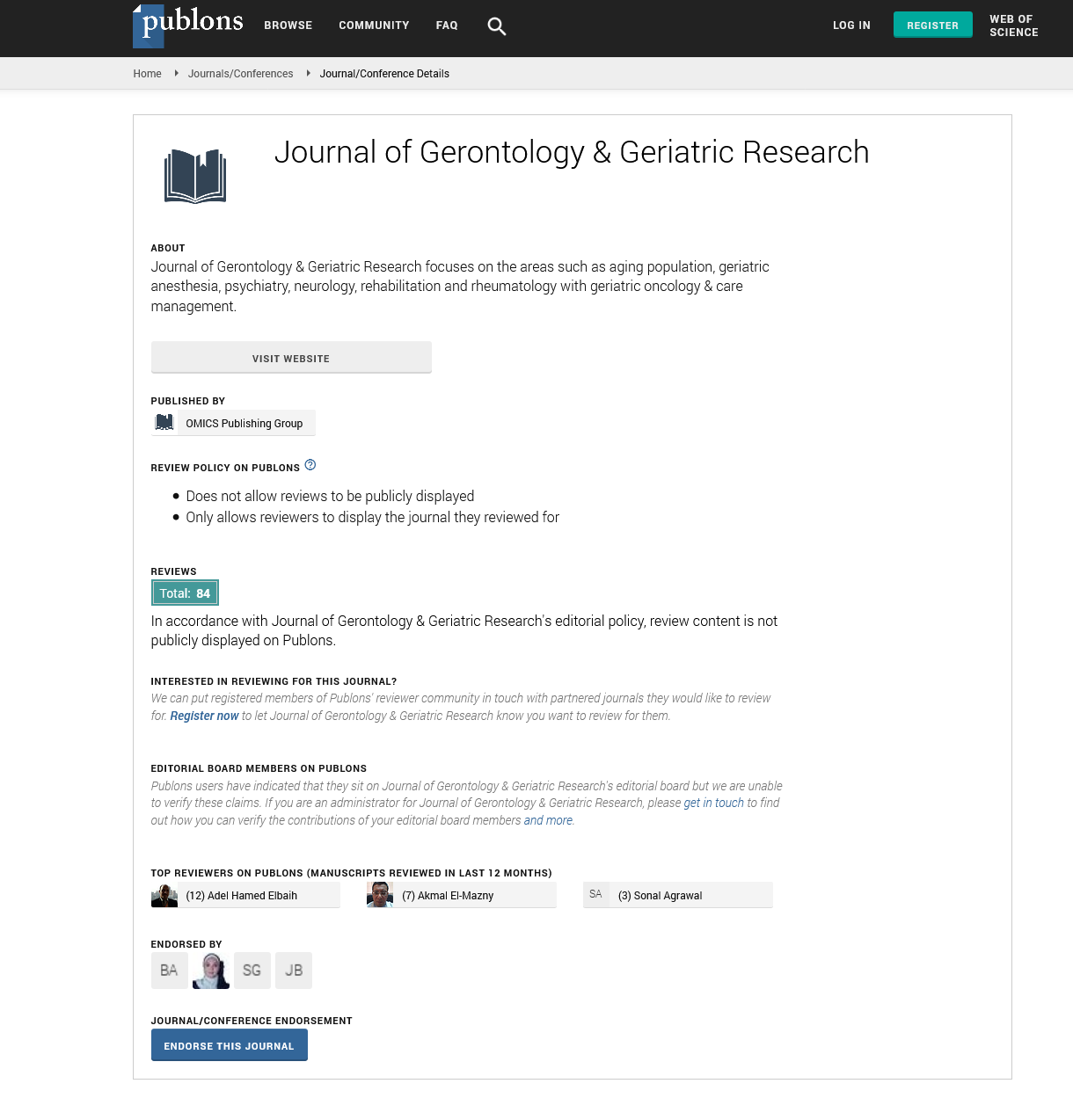Indexed In
- Open J Gate
- Genamics JournalSeek
- SafetyLit
- RefSeek
- Hamdard University
- EBSCO A-Z
- OCLC- WorldCat
- Publons
- Geneva Foundation for Medical Education and Research
- Euro Pub
- Google Scholar
Useful Links
Share This Page
Journal Flyer

Open Access Journals
- Agri and Aquaculture
- Biochemistry
- Bioinformatics & Systems Biology
- Business & Management
- Chemistry
- Clinical Sciences
- Engineering
- Food & Nutrition
- General Science
- Genetics & Molecular Biology
- Immunology & Microbiology
- Medical Sciences
- Neuroscience & Psychology
- Nursing & Health Care
- Pharmaceutical Sciences
Commentary - (2021) Volume 10, Issue 12
Adaptations of the Neuromuscular System to Ageing
Antonella Salis*Received: 09-Dec-2021 Published: 30-Dec-2021, DOI: 10.35248/2167-7182.21.10.588
Commentary
As children progress through childhood, adolescence, and adulthood, growth and maturation are responsible for a number of natural changes in the neuromuscular system, including changes in muscle-tendon architecture and muscle activation, as well as an increase in circulating androgens. These neuromuscular alterations may help to explain why children's sprint and jump performance improves as they get older. However, there is a scarcity of research that compares the size of these maturity-related changes and their implications on the mechanisms that drive performance increases. Muscle mass and strength decline as people get older. The term "sarcopenia" was coined by scientists to characterise the agerelated reduction of skeletal muscle mass. Others coined the term "dynapenia" to describe a loss of muscular mass. Many researchers have lately coined the term "muscle quality" to characterise the relationship between muscle strength and size in elderly people. However, whereas the majority of research has concentrated on intrinsic skeletal muscle features and mechanisms to explain muscle weakness in older adults, the central nervous system's possible role as a fundamental component of muscle function loss has received very little attention.
Impaired neurotransmission, which is governed by neurochemical variables, has also been linked to age-related deterioration in motor abilities. Evidence demonstrates that changes in neurotransmitters (NT) and their particular receptors are directly linked to cognitive and motor function impairments in the aged. In elderly people, abnormalities in NT-regulated systems such as serotonergic, cholinergic, adrenergic, dopaminergic, GABAergic, and glutamatergic systems have been identified. Several researchers claimed that the connection between glutamate, dopamine, and GABA plays a significant role in the deterioration of cortical and motor skills in the old, despite the fact that a complete understanding of how each system responds to ageing remains unknown. The changes in the NT-regulated systems have been linked to an increase in neural noise, which is defined as a random background activity in the brain signal.
Although glutamate is directly engaged in the control of excitatory inputs in the central nervous system, failures of the glutamatergic system have been attributed as one of the neurochemical mechanisms responsible for the increase in neural noise. According to several researches, ageing is associated with a considerable decrease in glutamate absorption. They discovered an excess of extracellular glutamate around cortical neurons, as well as a large increase in neural noise, which manifests itself as aberrant and unpredictable neural background activity, even during simple motor activities
The age-related decline in nerve conduction velocity has been attributed to the dysfunction of spinal motor neurons, as well as diminished axonal myelination and shorter internodal length. Reductions in the conduction velocity of peripheral efferent and afferent axon action potentials have been described frequently in the literature. Variations in nerve conduction velocity, as well as motor and sensory responses, are highly correlated with increasing age. The Hoffman (H) reflex has been shown to be a valid method for assessing the efficacy of spinal circuitry function using electromyography (EMG) and nerve stimulation. The effectiveness of Ia sensory afferent axons in activating spinal motor neurons is predominantly indicated by the H-reflex. EMG and nerve stimulation also allow for the study of the motor (M) wave, which assesses the direct activation of peripheral motor axons and, as a result, the size of the motor response.
Citation: Salis A (2021) Adaptations of the Neuromuscular System to Ageing. J Gerontol Geriatr Res. 10: 588.
Copyright: © 2021 Salis A. This is an open-access article distributed under the terms of the Creative Commons Attribution License, which permits unrestricted use, distribution, and reproduction in any medium, provided the original author and source are credited.

